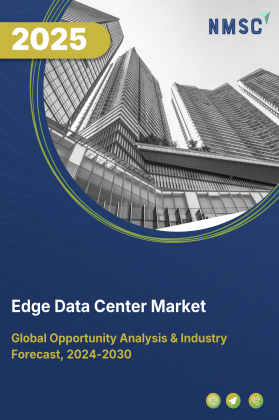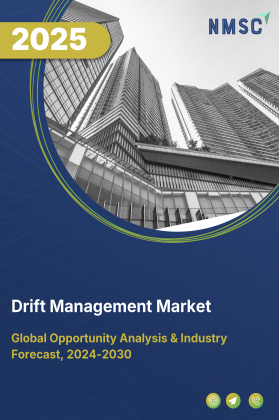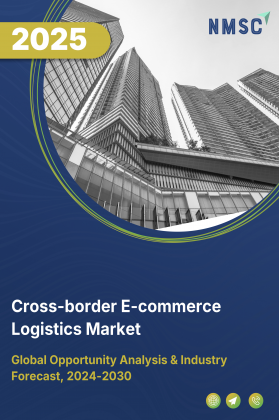
Edge Data Center Market by Component (Solutions, Services), by Facility Type (Small & Medium Facilities, Large Facilities), by Deployment Model (On-Premise Edge, Network Edge, Cloud-Integrated Edge), by Application (Edge Computing, IoT, AI & Machine Learning, 5G Networks, Others), and by End User (Telecommunications, Healthcare, Manufacturing, Retail & E-commerce, Finance & Banking, Government & Public Sector, Others) – Global Opportunity Analysis and Industry Forecast, 2025–2030
Edge Data Center Industry Outlook
The global Edge Data Center Market size was valued at USD 14.60 million in 2024, with an estimation of USD 18.08 million in 2025 and is predicted to reach USD 52.57 million by 2030 with a CAGR of 23.8% from 2025-2030.
The market is experiencing robust growth driven by the rapid adoption of IoT devices, the global rollout of 5G networks, and the increasing integration of AI and machine learning applications. These factors are fueling demand for localized data processing to support real-time analytics, automation, and next-generation technologies.
While high deployment and maintenance costs remain a key restraint, the market is witnessing strong opportunities from emerging applications such as autonomous vehicles, smart cities, and AR/VR, which require ultra-low latency and reliable connectivity. As enterprises and governments accelerate digital transformation initiatives, edge data centers are becoming critical infrastructure, positioning the market for significant expansion in the coming years.
Growing Adoption of IoT Devices Drives the Market Growth
The rapid proliferation of Internet of Things (IoT) devices across industries is a key driver of the edge data center market growth. From smart homes and connected vehicles to industrial automation and healthcare monitoring, IoT devices generate massive volumes of data that require real-time processing.
Traditional centralized data centers create latency and bandwidth constraints when handling this distributed data. Edge data centers address this challenge by processing and storing data closer to the source, enabling faster response times, improved efficiency, and enhanced user experiences. As IoT adoption accelerates globally, the demand for localized edge infrastructure continues to rise, fuelling industry growth.
5G Network Expansion Boosts the Market Demand
The rollout of 5G networks is a major catalyst for the growth of the edge data center market demand. Unlike previous generations of mobile networks, 5G requires ultra-low latency, high bandwidth, and reliable connectivity to support advanced applications such as autonomous vehicles, smart cities, augmented and virtual reality (AR/VR), and mission-critical IoT.
To achieve these capabilities, data must be processed closer to end users rather than being routed to distant centralized data centers. Edge data centers play a vital role in this ecosystem by hosting computing resources at the network edge, ensuring real-time responsiveness and reducing congestion on core networks. As telecom operators and enterprises accelerate 5G deployments worldwide, the demand for edge data center infrastructure is expanding significantly.
Growth of AI & Machine Learning at the Edge Fuels Market Expansion
The increasing deployment of artificial intelligence (AI) and machine learning (ML) applications is significantly driving the demand for edge data centers. AI-powered technologies, such as predictive maintenance in manufacturing, intelligent video analytics in surveillance, real-time diagnostics in healthcare, and personalized recommendations in retail, require rapid data processing close to the source.
Relying solely on centralized cloud data centers introduces latency and bandwidth challenges that undermine the effectiveness of these applications. Edge data centers address this gap by providing localized computing power, enabling AI and ML models to run in real time with higher efficiency and lower latency. As enterprises prioritize automation, real-time decision-making, and advanced analytics, the growth of AI and ML at the edge continues to fuel the edge data center market expansion.
High Deployment and Maintenance Costs Limit the Market Growth
One of the major restraints in the edge data center market is the high capital expenditure (CAPEX) and operational expenditure (OPEX) required for deployment and maintenance. Unlike centralized data centers, which benefit from economies of scale, edge data centers need to be distributed across multiple locations to serve end users effectively. This distributed nature increases costs related to site acquisition, infrastructure setup, power supply, cooling systems, and skilled workforce availability.
Additionally, ongoing operational expenses, such as energy consumption, hardware upgrades, and network management, further add to the financial burden. For small and medium-sized enterprises (SMEs), these high costs act as a barrier to adoption, slowing down market growth despite the rising demand for low-latency and real-time processing capabilities.
Rising Demand from Emerging Technologies Creates New Growth Opportunities
The rapid growth of emerging technologies such as autonomous vehicles, augmented and virtual reality (AR/VR), industrial automation, and smart cities presents a significant opportunity for the market. These applications require real-time data processing and ultra-low latency, which centralized data centers cannot fully provide.
Edge data centers deliver the necessary localized computing power to support these advanced use cases, enabling faster decision-making and seamless user experiences. As enterprises and governments increasingly invest in digital transformation projects powered by these technologies, the demand for edge infrastructure is expected to expand, opening substantial growth opportunities for data center providers and technology vendors.
Market Segmentations and Scope of the Study
The edge data center market report is segmented by component, facility type, deployment model, application, end-user, and region. By component, the market is divided into solutions, which include hardware and software, and services. By facility type, the market covers small & medium facilities and large facilities. Based on deployment model, it is categorized into on-premise edge, network edge, and cloud-integrated edge. By application, the market includes edge computing, IoT, AI & machine learning, 5G networks, content delivery & caching, data sovereignty & compliance, and others. By end-user, it spans telecommunications, healthcare, manufacturing, retail & e-commerce, finance & banking, government & public sector, media & entertainment, and others. Regional coverage includes North America, Europe, Asia-Pacific, and Rest of the World (RoW).
Geographical Analysis
One of the key drivers of the edge data center market share in North America is the rapid expansion of 5G networks, which is reshaping how and where data is processed. According to 5G Americas, by the end of 2024, the United States and Canada together recorded more than 182 million 5G connections, reflecting nearly 20% year-over-year growth. This surge in high-speed, low-latency connectivity is fueling the need to bring computing power closer to end users through edge facilities rather than relying solely on centralized hyperscale data centers.
As a result, edge data centers are being increasingly deployed to support latency-sensitive applications such as autonomous vehicles, IoT, AR/VR, online gaming, and smart city solutions, while also reducing network congestion and enabling new opportunities across industries like telecommunications, healthcare, automotive, and media.
Another key driver of the market in Europe is the rapid growth of IoT and smart city initiatives, supported by strong government and EU-level digitalization strategies. With the European Commission’s Digital Decade 2030 goals emphasizing widespread adoption of connected technologies, smart infrastructure, and sustainable digital transformation, there is a growing need to process and analyze vast amounts of IoT-generated data closer to the source.
Edge data centers play a critical role in enabling real-time decision-making for applications such as traffic management, energy optimization, industrial automation, and public safety. This push toward digital sovereignty and localized data processing is further reinforced by strict regulatory frameworks like the General Data Protection Regulation (GDPR), which encourages organizations to handle data within national or regional borders, making edge deployments even more attractive in Europe.
In the Asia-Pacific region, a major driver of the edge data center industry is the explosive growth of internet users and mobile data consumption, fueled by rapid digital transformation and the rise of applications that demand real-time processing. Countries like China, India, Japan, and South Korea are experiencing a surge in connected devices, e-commerce, online gaming, video streaming, and IoT deployments, which require faster data processing closer to end users.
Governments in the region are also investing heavily in smart city projects and 5G rollouts, China and South Korea leading globally in 5G penetration, further accelerating the need for localized computing infrastructure. In addition, Asia-Pacific’s diverse geography and massive population create strong demand for distributed edge facilities to ensure reliable, low-latency services across urban and rural areas, making digital connectivity and data sovereignty central to the region’s edge data center growth.
In the Rest of the World (RoW), a key driver of the edge data center market is the rising adoption of cloud services and digital platforms in emerging economies, particularly in regions like Latin America, the Middle East, and Africa. With increasing internet penetration, smartphone usage, and growing demand for digital services such as e-commerce, online education, fintech, and video streaming, there is a pressing need to process and store data closer to end users to ensure faster response times and improved user experiences.
Governments and private operators in these regions are also investing in digital infrastructure, including smart city projects and undersea cable expansions, which further push the need for edge deployments. Additionally, regulatory requirements around data localization are encouraging businesses to adopt regional data processing solutions, making edge data centers an essential component of the digital growth strategy across RoW markets.
Strategic Innovations Adopted by Key Players
Key players in the edge data center industry are focusing on high-performance product launches, large-scale infrastructure developments, and strategic collaborations to strengthen AI and edge computing capabilities.
-
In August 2025, NVIDIA unveiled the Jetson AGX Thor, a high-performance edge AI platform delivering up to 7.5× the compute power of its predecessor. Geared toward robotics and real-time AI use cases, this compact system empowers on-device generative AI without needing centralized data centers.
-
In July 2025, EdgeConneX Inc. developed a USD 440 Million, 578,000 sq ft edge campus (AUS02) near Austin, expected to complete by mid-2026. This project underscores its role in building AI-ready infrastructure near tech hubs.
-
In January 2025, NVIDIA teamed up with Cisco to embed its latest Tensor Core GPUs (Blackwell architecture) within Cisco’s M7 UCS servers, enhancing AI workload capabilities across data centers and the edge.
Key Benefits
-
The report provides quantitative analysis and estimations of the industry from 2025 to 2030, which assists in identifying the prevailing edge data center market opportunities.
-
The study comprises a deep-dive analysis of the current and future edge data center market trends to depict prevalent investment pockets in the sector.
-
Information related to key drivers, restraints, and opportunities and their impact on the market is provided in the report.
-
Competitive analysis of the key players, along with their market share is provided in the report.
-
SWOT analysis and Porters Five Forces model is elaborated in the study.
-
Value chain analysis in the market study provides a clear picture of roles of stakeholders.
Edge Data Center Market Key Segments
By Component
-
Solutions
-
Hardware
-
Software
-
-
Services
-
Professional
-
Managed
-
By Facility Type
-
Small & Medium Facilities
-
Large Facilities
By Deployment Model
-
On-Premise Edge
-
Network Edge
-
Cloud-Integrated Edge
By Application
-
Edge Computing
-
IoT
-
AI & Machine Learning
-
5G Networks
-
Content Delivery & Caching
-
Data Sovereignty & Compliance
-
Others
By End User
-
Telecommunications
-
Healthcare
-
Manufacturing
-
Retail & E-commerce
-
Finance & Banking
-
Government & Public Sector
-
Media & Entertainment
-
Others
By Region
-
North America
-
The U.S.
-
Canada
-
Mexico
-
-
Europe
-
The UK
-
Germany
-
France
-
Italy
-
Spain
-
Denmark
-
Netherlands
-
Finland
-
Sweden
-
Norway
-
Russia
-
Rest of Europe
-
-
Asia-Pacific
-
China
-
Japan
-
India
-
South Korea
-
Australia
-
Indonesia
-
Singapore
-
Taiwan
-
Thailand
-
Rest of Asia-Pacific
-
-
RoW
-
Latin America
-
Middle East
-
Africa
-
Key Players
-
Cisco Systems Inc.
-
Eaton
-
EdgeConneX Inc
-
Hewlett Packard Enterprise Development LP
-
Huawei Technologies Co., Ltd
-
Schneider Electric.
-
365 Data Centers
-
American Tower Corporation
-
Flexential Corporation
-
Vapor IO, Inc
-
Vertiv
-
Rittal
-
Acromove Inc
Report Scope and Segmentation
|
Parameters |
Details |
|
Market Size in 2025 |
USD 18.08 Million |
|
Revenue Forecast in 2030 |
USD 52.57 Million |
|
Growth Rate |
CAGR of 23.8% from 2025 to 2030 |
|
Analysis Period |
2024–2030 |
|
Base Year Considered |
2024 |
|
Forecast Period |
2025–2030 |
|
Market Size Estimation |
Million (USD) |
|
Growth Factors |
|
|
Countries Covered |
28 |
|
Companies Profiled |
15 |
|
Market Share |
Available for 10 companies |
|
Customization Scope |
Free customization (equivalent up to 80 working hours of analysts) after purchase. Addition or alteration to country, regional, and segment scope. |
|
Pricing and Purchase Options |
Avail customized purchase options to meet your exact research needs. |

















 Speak to Our Analyst
Speak to Our Analyst

























